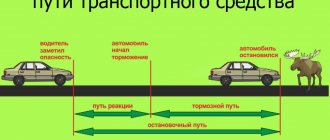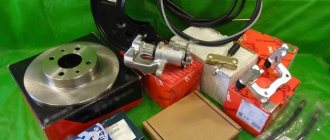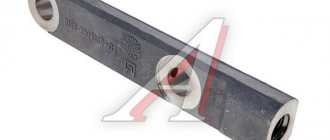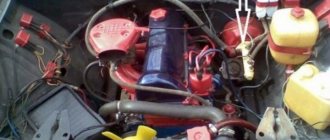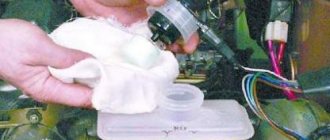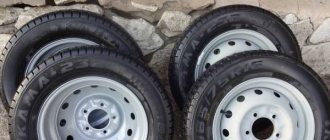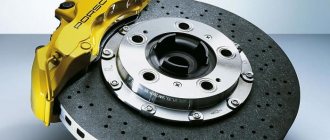Braking distance is the distance it takes for a vehicle to come to a complete stop from the moment the braking system begins to operate.
In everyday life, this term is often confused with stopping distance, but braking distance and stopping distance are different concepts. In the latter case, the distance elapsed from the moment the driver realized the need to brake to a speed of 0 km/h is taken into account. The braking distance is part of the stopping distance.
This cannot be avoided when performing calculations.
Another important indicator is the length of the skid when braking. This is the ratio of the square of the skid speed to twice the deceleration constant j. The car wheels blocked by chocks begin to leave such a mark on the road surface when the pedal is in the “pedal to the floor” position. The beginning of the trace is the point of steady deceleration, that is, constant. As mentioned above, this is an experimental value. It is calculated for each type of transport separately. In this case, the physical formula is used
j = f*g,
The longitudinal adhesion of rubber to the road surface f is measured empirically, using a “fifth wheel” or special devices.
Based on a special table, the driver’s reaction time to the situation on the road is 0.6-1.4 seconds (step 0.2). The average expert value, which is used in official examinations, is 0.8 s (due to the fact that the human brain is not able to react to what is happening faster than this time).
To simplify the perception of the mathematical calculations being made, we will link the stopping distance to the speed of a car 4 m long. The link is made to a speed of 64 km/h, with a step of ½ in the direction of its slowdown and increase:
| Speed car, km/h | The way to the driver's reaction, m | The distance from the start of braking to the stop, m | General stopping path, m/length t/s |
| 32 | 6 | 6 | 12/3 |
| 48 | 9 | 14 | 23/6 |
| 64 | 12 | 24 | 36/9 |
| 80 | 15 | 38 | 53/13 |
| 96 | 18 | 55 | 73/18 |
| 112 | 21 | 75 | 96/24 |
Making a decision to start braking in a critical situation is a necessary and extremely responsible step. The higher the speed of the car, the faster you need to press the pedal. The sooner this decision is made, the sooner a complete stop will occur.
Braking distance formula
Let's consider the two most popular formulas:
1) S =V2/2μg.
Description:
- μ is an indicator of adhesion;
- g - 9.81 m/s - this is the value of the acceleration of free fall;
- V is the vehicle speed at the beginning of braking (indicated in m/s).
2) S=Ke*V*V/(254*Fs).
Description:
- Fc is the coefficient of adhesion of the vehicle to the road surface;
- V0 is the vehicle speed at the beginning of braking (indicated in km/h);
- Ke is the actual braking coefficient;
- S is the braking distance (indicated in meters).
To determine the braking distance, it is better to use a special speed calculator. Such services are available on specialized websites.
Braking a car at speed. What is the braking distance at speeds of 50, 80 and 110 km/h.
Most automakers like to brag about their products, thus advertising various technical characteristics of their cars, focusing mainly on the dynamics of acceleration from 0 to 100 km/h. But not a single car company talks about how quickly any of their cars stop in place.
In our opinion, such data is extremely necessary for drivers to remind them that an object moving on the road cannot be stopped instantly. Naturally, each car, due to the characteristics of the braking system, has its own individual braking distance. But still, there is a specific table of average values showing what kind of braking distance virtually any car has at a certain speed. For our part, we advise every driver to learn it by heart.
It is natural and understandable to everyone, and this must be remembered, the higher the speed of your car, the longer the braking distance will be during sudden emergency braking. It is also necessary to take into account weather conditions, as well as the road surface and the very condition of the car tires. By memorizing the braking distance parameters at different speeds like a multiplication table, you will be able to better control your car while driving, maintain the correct distance and, if necessary, be able to brake in time and urgently, thereby avoiding an accident.
This is especially important for novice drivers who have only recently received their license and got behind the wheel of a car.
What determines the braking distance?
The value of the braking distance parameter depends on many factors. Some of them depend on the car owner himself (for example, maintaining the working order of the brake system and the ability to use it correctly), while others depend on external factors, for example:
- on the condition of the road surface;
- its quality;
- from weather conditions (presence of water or snow on the canvas).
As a result, we can conclude that the value of this parameter is not constant. After all, it will change in tandem with changes in external conditions.
How to calculate the braking distance of a car.
Most car owners probably know how quickly a car accelerates. Even if you haven’t measured the acceleration dynamics of your car, you’ve probably looked at the factory specifications of your car, where the automaker usually indicates the minimum possible acceleration time from 0-100 km/h. But now the question is: how long does it take to stop your car? Do you know this? We are sure not. But it turns out that you can calculate the braking distance quite easily using a simple formula. We'll tell you how it's done.
There is no such thing in the Universe or matter that can stop instantly. Likewise, any car, when you press the brake pedal, may not stop immediately. The fact is that in order for a car or any object in our world to stop, it is necessary for it to lose the energy that moves it. As a result, any car has a braking distance that it covers from the moment you press the brake pedal until it comes to a complete stop. This is the braking distance of the car.
But in fact, the braking distance of any car depends not only on its characteristics and braking system, but also on the driver’s reaction when pressing the brake pedal. After all, in order to make a decision about the need to brake and press the brake pedal, time is required, which, although minimal, is enough for the car to cover a long distance.
This is especially important at high speeds, where in a few fractions of a second the car travels a considerable distance. So, in the end, in order to calculate the actual braking distance, you need to take into account not only the time and distance traveled by the car from the moment the driver presses the brake pedal until the car stops, but also the time required to make a decision to brake
The fact is that when making a decision to brake, we waste precious seconds. Here's an example:
Response Time: Before the driver presses the brake pedal, he must assess the driving situation and determine whether braking is necessary. You also need to understand what kind of braking is necessary - a complete stop of the car or a simple reduction in speed. Typically, according to numerous studies, most drivers need about 0.1 seconds to do this.
Time required to press the brake pedal: After the driver has realized that he must brake, it takes approximately 0.8 seconds to move his foot from the gas pedal to the brake pedal and press it.
In addition, even when the brake pedal is pressed, there is still a small loss of time due to the fact that when the brake pedal is pressed, the car, as a rule, does not begin to brake sharply. And in order for the car to actually begin to sharply reduce speed, it is necessary to increase the pressure on the brake pedal (the threshold time required for the required brake pressure in the brake system). Also, all cars have different response times to the brake pedal. Everything here, of course, depends on the design of the brake system and the presence of various electronics that control the car’s brakes.
You won’t believe it, but in order for the car to actually start braking after pressing the brake pedal, almost 1 more second of time is needed. Can you imagine how much this is when driving at high speed? In that extra second you can travel a very long way.
What does braking distance depend on?
Obviously, the braking distance will vary depending on the situation and its conditions. Thus, factors influencing the magnitude of this path are divided into two groups:
- Factors that depend on the motorist.
- Factors that are beyond the control of the motorist.
Conditions that are independent of who is driving include weather and road surface conditions. As for the weather, it is logical that in rain, snow or ice it will take more time to stop the car than in dry weather.
The road surface also affects braking distance. If the road is smooth without adding stone, then the distance that the vehicle will travel when braking will also be greater.
On a note! If there are potholes on the roads, then most likely the braking distance will be short. This is due to the fact that on such a bad section of the road the driver simply will not reach high speed.
There are many more factors that depend on the driver (car owner):
- speed. Logically, the lower the speed, the shorter the braking distance;
- condition and design of the brake system. It is important that the car, including its brakes, works properly, that the pads are not worn out, and that the tire pressure is sufficient.
- type of tires installed. The tread should not be heavily worn, and the type of tire installed should be suitable for weather conditions;
- loading the car. The lighter the vehicle, the easier it is to stop it. The braking distance of a loaded vehicle will be longer;
- presence of ABS system. On dry asphalt, this system will help stop the car faster, but in icy conditions it will allow you to maintain control, but the braking distance will become longer;
- sober state of the driver. An adequate driver reacts faster to a rapidly changing situation on the road, thanks to which he will quickly stop his vehicle if necessary;
- absence of distractions while driving. Often, a motorist's slow reaction is due to the fact that he is distracted and does not watch the road. The most common distraction is the mobile phone. Due to the slower reaction of the person driving the car, the braking distance increases.
Distraction on the road.
When we are driving, we must be as attentive as possible and focused specifically on the road. But unfortunately, we are often distracted by something on the road, as a result of which our reaction while driving is reduced and this usually leads to an accident (accident).
For example, the driver’s main enemy is a mobile phone, or a smartphone, or a tablet. According to the current legislation in our country there is a ban on the use of mobile devices while driving a car. But to our regret, few drivers in Russia comply with this current law.
But this ban, friends, was actually made for a reason.
The point is this: according to studies, such conversations on a cell phone while driving a car distract the driver and reduce his attention. In particular, due to a mobile phone, the driver’s reaction also drops significantly
For example, it was officially established that a driver talking on a mobile phone while driving a car begins to behave in exactly the same way as a driver driving a car while slightly intoxicated. Why is this happening? But the thing is that our brain is not limitless and cannot process too much information at the same time. As a result, it turns out that when we talk on the phone while driving a car, our reaction decreases several times, which often becomes the cause of accidents. For example, due to the fact that the driver started to brake at the wrong time, this ultimately led to an increase in the braking distance of the car.
All of the above factors directly affect the final stopping distance when the car is braking. After all, all these things lead to an increase in the time for the car to come to a complete stop, which ultimately leads to a longer braking distance.
Concept of car braking distance
Braking distance is the distance covered by a car from the start of braking (the moment the drive is activated) to a complete stop.
What factors affect braking distance?
Human life is priceless. In an emergency situation (accident), braking distance is a decisive factor that cannot be ignored. Because every meter can cost a life.
Study the factors that affect stopping distance. This knowledge will help you stay healthy and avoid accidents:
- the driver will take timely measures to reduce speed;
- the pedestrian will have the opportunity to assess the safety of the crossing.
1) Condition of car tires. Tires are one of the most important elements of a wheel. They ensure safety while the vehicle is moving.
When choosing a tire, you need to pay attention to the tread height. What is a protector? This is a tire element
It protects the tire from damage and punctures. Correctly selected tires will ensure good vehicle control.
The vehicle's road grip indicator directly depends on the technical condition of the tread. There is a wide range of tires on the market. The tread depth is 5–17 mm.
In this case, you need to separate winter and summer tires:
- the tread of winter tires is 8.5–9.5 mm;
- The tread of summer tires is 7.5–8.5 mm.
Based on the results of the experiments, it was found that when the tread wears out, the braking distance of the car increases significantly. The tread wears out during use. Therefore, the friction force is significantly reduced.
In winter, be sure to use only winter tires. Whereas in the summer - summer tires. This will ensure optimal machine control. To make winter tires, special soft rubber is used.
Such products have deep grooves and a ribbed pattern. These features provide excellent grip in the winter season. And for the manufacture of summer tires, hard rubber is used.
2) Condition of the brake system. This system is designed to stop the car, as well as to reduce the speed of movement. This is one of the most important systems in the car. Because it provides security.
Let's consider point 2.3.1. Traffic rules It is prohibited to drive a vehicle with faulty brakes. A malfunction of this system results in loss of vehicle braking efficiency.
It is imperative to take into account the response time of this system. According to the requirements, the response time is no more than 0.6 s.
Let's consider the factors that affect the response time:
- system design;
- type;
- state;
- quality.
The length of the braking distance depends on the response time of this system.
3) Initial speed of the vehicle. The higher your speed, the longer the path will be.
4) Road surface.
5) Machine condition.
6) Weather conditions.
7) Braking method:
- stepwise pressing (full wheel locking);
- intermittent pressing (the vehicle stops quickly, and control may be lost);
- gradual increase in pressure (used in good visibility and in a calm environment);
- pressing hard until it stops (this method can lead to uncontrolled wear).
Driver skills. An experienced driver will be able to quickly navigate in an emergency situation.
Why know the braking distance?
Since we started with calculations, talking about the length of the braking distance of a moving car, we use a simple physical formula known to every schoolchild. It is used to calculate the transition of the fall energy into the kinetic energy at the end of the path (mgh=mVx2/2). From this we get that at a speed of about 30 km/h the body receives a shock equal to a fall from a height of three meters. Accordingly, when driving at a speed of 60 km/h, the impact force will be equal to a fall from a height of 15 m, and already at a speed of 90 km/h - from a height of about 32 m; 120 km/h is already a height of 55 meters.
Even considering that the car's airbag deploys, there is very little chance of surviving a frontal impact at a speed of 60 km/h. This is the approximate height of the Khrushchev building. Would anyone dare to jump from the roof of a five-story building wearing inflatable pillows? Hardly. What can we say about a speed of 90 km/h, the impact of which is equivalent to falling from the height of a ten-story building? And from a height of 55 meters? There is no chance of survival, and this is even if the airbag works flawlessly.
More on AutoLex.Net:
Calculation of the braking distance of a car
Speed.
As you can see above in the picture and in the table itself, high vehicle speed results in longer braking distances. But in addition to the speed itself, as you can see, the speed of your reaction before you press the brake pedal also plays an important role. On average, most drivers have approximately the same speed of reaction to an emergency situation on the road when making a decision to brake. As we can see from the table, the higher the speed, the longer the distance traveled until the very moment we press the brake pedal. And this takes into account the fact that the speed of our reaction does not change.
Important to know: How to check brake fluid
This is a compelling argument to encourage drivers not to violate the speed limit. This is especially necessary in populated areas within the city. This is why many cities have speed limits of 40 km/h.
Safe distance between cars
According to clause 13.1 of the Traffic Rules, the driver must keep a sufficient distance from the vehicle in front that will allow him to brake in time.
Failure to maintain distance is one of the main causes of transport accidents.
When a vehicle in front comes to a sudden stop, the driver of a car closely following him does not have time to brake. The result is a collision between two and sometimes more vehicles.
To determine the safe distance between cars while driving, it is recommended to take an integer speed value. For example, the speed of a car is 60 km/h. This means that the distance between him and the vehicle in front should be 60 meters.
Where does the brake fluid go - sources of leakage?
Crack in the brake fluid reservoir
First of all, inspect the tank itself, this may be the reason. Do not rush to immediately disassemble the floor of the car in order to find the cause of the brake fluid leak. In general, it is best to look for the source of the malfunction by following the characteristic traces of leakage; they will show you the location, as well as the cause of the leakage of the fuel fluid.
Violation of the integrity of the brake cylinder
If your brake cylinder is leaking, the fuel fluid level will constantly drop, and under the car after long periods of inactivity, as a rule, there will be stains of fuel fluid on the asphalt. In order to confirm or refute this assumption, it is necessary to perform an inspection. To do this, remove the wheels and carry out a visual inspection of the front discs, check for any leaks on the calipers. If you have drum brakes on the rear wheels, you will also have to remove the drums. A leak in the rear brake cylinder is most often associated with damage to the rubber seals; they may be of poor quality or cracked over time. In winter, this problem is very urgent, the seals “dull” and leakage of fuel fluid occurs.
Damage to the brake hose
To establish this malfunction, a visual inspection will also be sufficient; you can touch the hoses with your hands to make sure they are in good condition. If the hoses feel hard to the touch or crack when bent, replace the hoses with new ones. Check for leaks on the hoses; they must be completely dry. Sometimes it happens that the brake hose simply flies off the fitting, in which case you need to put it in place and secure it using special clamps or replace the hose with a similar one, only of a smaller diameter.
The main brake cylinder (GTC) is faulty
In this case, it is necessary to inspect the gas turbine housing; in most cases, the leak occurs precisely because of the seal. A crack may form in the rubber seal, which causes fuel fluid leakage. Other scenarios are also possible, for example, when the brake fluid goes into the “vacuum reservoir”, while there are no signs of leakage outside; in order to detect this malfunction, it is necessary to remove the brake master cylinder. After removing the brake cylinder, remove it from the “vacuum chamber”, if you find a leak inside the “vacuum chamber” - completely replace the entire brake cylinder.
Start the engine, put it in neutral and apply the brake. If the cause of the brake fluid leak is in the hydraulic drive, the pedal will gradually “fail”. If you press the brake pedal and it reaches almost to the floor, the problem will be associated with a malfunction of the brake circuit.
After completing all repair work, it is MANDATORY to bleed the brake system. Also consider the fact that brake fluid is hygroscopic, so it must be changed after a certain period of time.
Issues discussed in the material:
- Where does the brake fluid go?
- How to detect a leak
- How to fix a brake fluid leak yourself
- Is it possible to get to your destination if brake fluid leaks on the road?
The braking system of a car operates using brake fluid (BF). An expansion tank is provided for it, on the body of which there are marks, by which you can find out what the volume of fluid is in the brake system. The lowest permissible level is marked min, and the highest, accordingly, is marked max. The brake system will operate normally when the fluid level is between these two marks. Some drivers prefer to add brake fluid to the maximum value.
If you see that its level drops sharply, and brake fluid leaks are found on the wheels, this is a signal to urgently take action; driving a car with such a malfunction becomes dangerous.
How to brake on a motorcycle?
Braking correctly on a motorcycle is quite a difficult task. You can brake with the rear wheel, the front wheel, or both, skid or engine. If you brake incorrectly at high speeds, you can lose your balance. In order to calculate the braking distance of a motorcycle at 60 km/h, we also substitute the data into the formula. Taking into account the different braking coefficient and friction coefficient.
Motorcycle braking distance
- Dry asphalt: 23 – 33 meters
- Wet asphalt: 35 – 46 meters
- Mud and snow: 70 – 95 meters
- Ice: 95 – 128 meters
The second indicator is the braking distance when the motorcycle is skidding.
Any vehicle owner should know and be able to calculate the braking distance, and it is better to do this visually.
It should be remembered that if a traffic accident occurs, by the length of the skid that will remain on the road surface, you can determine the speed of the vehicle before colliding with an obstacle, which can indicate that the driver has exceeded the permissible speed and make him the culprit of the incident.
What is the difference between braking distance and stopping distance?
Braking and stopping distances are different concepts that are often confused or mistaken for the same thing.
The stopping distance is the distance that the vehicle has traveled from the moment the motorist realizes the need to stop until the car reaches a speed of 0 km/h.
And the braking distance is the distance that the car has traveled from the moment its brakes are applied until it stops.
Thus, the stopping distance includes not only the braking distance, but also the distance the vehicle traveled while the motorist was reacting to the traffic situation.
Calculation of speed during examination
To expertly determine the initial speed of a machine, specialists use the formula:
Va = 0.5*tз*j + √2Sь*j,
Where
tз – time during which the vehicle speed slows down, s;
j – deceleration constant at the moment of braking, m/s2 (determined by reference, based on GOST 25478-91);
Sу – length of the trail during braking, m.
On a dry road, j is equal to 6.8 m/s2, so the skidding speed of a car braking at a distance of 21 meters is 64.5 km/h.
After the driver begins to react to the environment, the car goes through the so-called stopping distance until the speed is completely zeroed.
So = (S1 + S2 + S3 + S4) = (t1 + t2 + 0.5*t3)*Va + Va/2j,
Where
t1 – driver reaction;
t2 – delay of the hydraulic drive of the brake system;
tз – increase in deceleration.
The time interval t4 (full stop time) is calculated as the ratio of the skidding speed Vу to the deceleration j. The time until the deceleration rate increases depends on three indicators:
- type of drive;
- road surface condition;
- vehicle weight.
To determine it, half should be subtracted from the initial speed Va until the minimum speed tз*j is established. Thus, the total time of the dynamic part of an accident for a car is t0 = t1 + t2 + t3 + t4 = T + Va/j, s.
Attention! The deceleration increase time for a pneumatic drive is longer than for a hydraulic drive. It increases with the curb weight of the vehicle and the coefficient of adhesion.
What to do if a leak is detected from the tank?
If the brake fluid reservoir is faulty, cracks may appear on it, through which the fluid will certainly flow out under the applied pressure. The tank cannot be repaired, so if it malfunctions, it must be urgently replaced. Do not forget that operating a vehicle with a faulty brake system is strictly prohibited.
To replace the reservoir, you must first drain the brake fluid from the system. To do this, prepare an empty container and place it under the drain bolt on the master cylinder. Unscrew this bolt and wait until the brake fluid is completely drained from the reservoir. To speed up the process, you can ask your partner to vigorously press the brake pedal to create the desired pressure in the system. After this, the reservoir is twisted off the brake cylinder, and a new one is installed in its place. Then you need to add brake fluid and bleed the brake system, not forgetting to tighten the bolt on the master cylinder.
What is a car's braking distance?
Braking distance is the distance covered by a vehicle from the moment you press the brake pedal until it comes to a complete stop. It is important to note that the beginning of the braking distance is considered to be the moment when the vehicle’s braking system is activated. During an emergency stop, this is evidenced by dark tire marks on the asphalt, making it easy to measure this distance. Typically, its length ranges from 5 to 100 meters, depending on a number of factors.
A vehicle cannot stop instantly, since the laws of physics do not allow it to do so. The length of the braking distance is primarily influenced by the speed at which the driver was traveling at the moment he pressed the brake pedal. Of course, the faster the car moved, the greater the distance it would have to travel before it came to a complete stop.
Another important factor on which the length of the braking distance depends is weather conditions. For example, ice can generally cause a car to go into an uncontrolled skid. It is very important in winter to use tires with studs or Velcro, and also to observe the speed limit on the highway and in the city. In addition, the grip of the wheels on wet asphalt deteriorates, which can also cause an increase in braking distance. All these points must be taken into account when driving in the rain or when the air temperature outside the window is below freezing.
Worn tires or flat tires can also be a factor affecting stopping distance. The more worn out the tire tread is, the worse the car’s grip on the road. This fact should be taken into account during the off-season “re-shoeing” of the car, since by using worn tires you save on your own safety. It is usually recommended to change tires once every 5-7 years, depending on the intensity of use and driving style.
Another factor due to which the braking distance can increase several times is worn out pads, lack of brake fluid and other malfunctions of the brake system. If the driver reacts in time to a change in the road situation and manages to press the brake pedal, the technology’s task is to instantly transfer this force to the car’s wheels. A delay of even a split second can cause an accident, especially at high speed.
